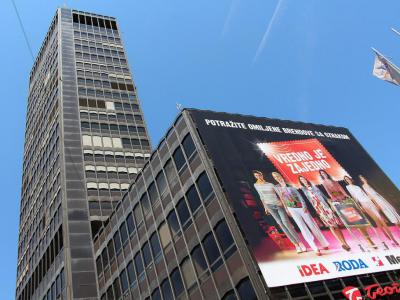
Beograđanka, Belgrade
The Beograđanka ("Belgrade Lady"), officially known as the Belgrade Palace, is a prominent modern high-rise building situated in the downtown area of Belgrade. Standing at 101 meters (331 feet) tall, it is an iconic symbol of the city and represents the "golden age" of Belgrade's development during the 1965-1974 mayoral term of Branko Pešić.
The site where Beograđanka now stands originally hosted the House of Jeremija Milivojević, a one-floor, corner house built in 1890. This house featured facades decorated in the Academism style. In 1941, just before World War II reached Yugoslavia, there were plans to construct a high-rise on this location, funded by the Teokarević family, major Serbian textile magnates.
Construction of Beograđanka began in 1969 under the leadership of two men named Branko Pešić, both hailing from Zemun: one was the mayor of Belgrade and the other was the architect of the building. Mayor Pešić laid the building's foundation charter on March 29, 1969, and the building officially opened on April 22, 1974.
Located in the heart of Belgrade's old city center, the building stretches from Terazije to Slavija Square. Its 24-story structure serves as a notable city landmark. For many years, an observation deck operated on the 22nd floor, accompanied by the "Beograđanka" restaurant, famous for its gold-plated decorative tiles. The restaurant closed in 1989 when "Studio B" (municipal TV and radio) acquired the floor.
The building's façade is composed of aluminum drapes and double-paned thermopane glass, with electronically operated outer blinds. The materials were imported from Italy, and city officials chose the darker façade material for its higher quality, despite mixed public reception. The entire façade spans 11,500 square meters (124,000 square feet).
The site where Beograđanka now stands originally hosted the House of Jeremija Milivojević, a one-floor, corner house built in 1890. This house featured facades decorated in the Academism style. In 1941, just before World War II reached Yugoslavia, there were plans to construct a high-rise on this location, funded by the Teokarević family, major Serbian textile magnates.
Construction of Beograđanka began in 1969 under the leadership of two men named Branko Pešić, both hailing from Zemun: one was the mayor of Belgrade and the other was the architect of the building. Mayor Pešić laid the building's foundation charter on March 29, 1969, and the building officially opened on April 22, 1974.
Located in the heart of Belgrade's old city center, the building stretches from Terazije to Slavija Square. Its 24-story structure serves as a notable city landmark. For many years, an observation deck operated on the 22nd floor, accompanied by the "Beograđanka" restaurant, famous for its gold-plated decorative tiles. The restaurant closed in 1989 when "Studio B" (municipal TV and radio) acquired the floor.
The building's façade is composed of aluminum drapes and double-paned thermopane glass, with electronically operated outer blinds. The materials were imported from Italy, and city officials chose the darker façade material for its higher quality, despite mixed public reception. The entire façade spans 11,500 square meters (124,000 square feet).
Want to visit this sight? Check out these Self-Guided Walking Tours in Belgrade. Alternatively, you can download the mobile app "GPSmyCity: Walks in 1K+ Cities" from Apple App Store or Google Play Store. The app turns your mobile device to a personal tour guide and it works offline, so no data plan is needed when traveling abroad.
Beograđanka on Map
Sight Name: Beograđanka
Sight Location: Belgrade, Serbia (See walking tours in Belgrade)
Sight Type: Attraction/Landmark
Sight Location: Belgrade, Serbia (See walking tours in Belgrade)
Sight Type: Attraction/Landmark
Walking Tours in Belgrade, Serbia
Create Your Own Walk in Belgrade
Creating your own self-guided walk in Belgrade is easy and fun. Choose the city attractions that you want to see and a walk route map will be created just for you. You can even set your hotel as the start point of the walk.
Kalemegdan Park and Belgrade Fortress Walking Tour
The most beautiful park in Belgrade, Kalemegdan Park, or simply Kalemegdan, is also the largest park and the most important cultural and historical complex in the city. The actual park occupies a smaller portion, in the southern corner, of another, grander monument – the Belgrade Fortress (which is some two millennia older).
The fortress itself, often erroneously referred to, even by the... view more
Tour Duration: 2 Hour(s)
Travel Distance: 2.1 Km or 1.3 Miles
The fortress itself, often erroneously referred to, even by the... view more
Tour Duration: 2 Hour(s)
Travel Distance: 2.1 Km or 1.3 Miles
Belgrade Old Town (Zemun) Walking Tour
Belgrade's Old Town, also known as Zemun, spread around Gardos Hill, is one of the city's oldest parts. Throughout the centuries, as the Balkans were part first of the Roman, then the Byzantine, and then the Austro-Hungarian empires, this area transformed into a beautiful neighborhood with narrow streets, cute buildings, and breathtaking views opening from the hill onto the Old Town and... view more
Tour Duration: 2 Hour(s)
Travel Distance: 2.4 Km or 1.5 Miles
Tour Duration: 2 Hour(s)
Travel Distance: 2.4 Km or 1.5 Miles
Belgrade Introduction Walking Tour
Belgrade has been a city of strategic importance for millennia with its location at the confluence of the Sava and Danube rivers. In fact, it is one of the oldest continually inhabited cities on the planet.
Nomadic tribes inhabited the area as far back as 20,000 to 50,000 years ago. Some of these may have been Neanderthals rather than modern humans. By the sixth century BC, the Vinca culture... view more
Tour Duration: 2 Hour(s)
Travel Distance: 4.0 Km or 2.5 Miles
Nomadic tribes inhabited the area as far back as 20,000 to 50,000 years ago. Some of these may have been Neanderthals rather than modern humans. By the sixth century BC, the Vinca culture... view more
Tour Duration: 2 Hour(s)
Travel Distance: 4.0 Km or 2.5 Miles



